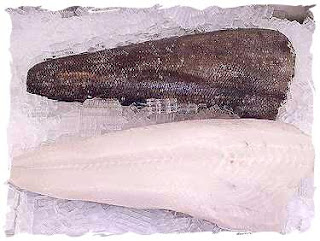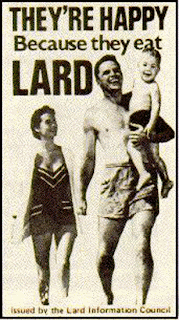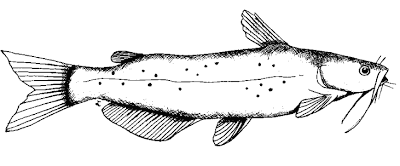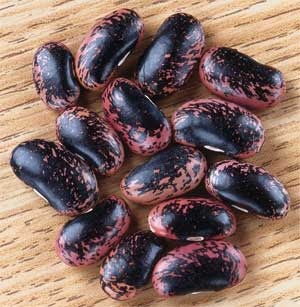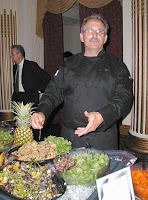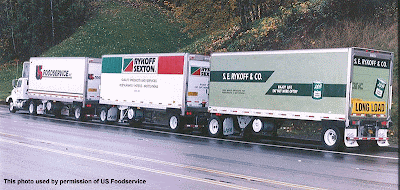
Pork is big business: it is the world's most widely-eaten meat. It therefore is rather apt that pigs are responsible for the naming of one of the world's leading financial centers. To stop free-roaming pigs rampaging through their grain fields, Manhattan Island residents built a long wall on the northern edge of what is now Lower Manhattan. The street that came to board the wall was named... Wall Street.
The break down of the pig:
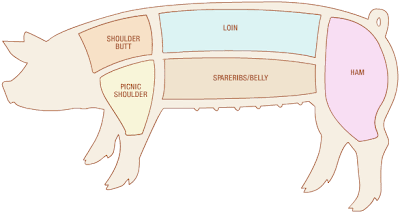
Leg Muscles:


Bottom Muscle, Bottom with Eye, Bottom, Eye Removed
The Bottom is the largest muscle in the ham.
The Bottom is also identified as the Outside muscle, and may have the eye(finger) muscle attached or removed.
Common weight range: 2-6 lbs.
IMPS Reference #402E.

Top Muscle, Top with Cap (Gracilis muscle), Top, Cap Removed
The Top is the second largest muscle in the ham and is also identified as the inside.
The Top is a high quality muscle and is known as the most tender cut of the ham.
The Top contains the Gracilis muscle, or cap.
Common weight range: 3-5 lbs.
IMPS Reference #402F.

Knuckle
The Knuckle is the third largest muscle in the ham.
The Knuckle contains ears, or flaps located on the sides of the Knuckle, which can be removed to eliminate color distortion, or two-toning in the muscle.
Common weight range: 1 1/2 lbs.

Outer Shank Boneless
The Outer Shank meat has been removed from the Shank bone.

Outer Shank Bone-in
The Outer Shank meat is left on the Shank bone.
Can be smoked or fresh.

Inner Shank
The Inner Shank meat sits on the inside of the ham at the base of the Shank bone.
The Inner Shank is also referred to as the Heel.

Femur or Center Bone
The Femur or Center bone is the largest bone in the Ham.
The Femur has a ball on one end connecting it to the Aitch bone, and a socket on the other end connecting it to the Shank bone.
The Femur bone lays in the middle of the Ham and is not visible from the outside of the Ham.

Aitch Bone
The Aitch bone is the back half of the pelvic bone located on the butt side of the ham. The face of the Aitch bone, along with the Sacreal Vertebrae, is used as a guide to make the break for the Ham-Loin separation.
The open socket of the Aitch bone connects to the ball of the Femur bone.

Shank Bone
The Shank Bone connects the Ham to the foot.
The Shank should be cut just above the knee joint on the rear leg.
This break should be made so that the two bones on the shank are still fused together for Ham hanging purposes.
PIT HAM 101What is a PIT style ham? PIT stands for Partially Internally Trimmed ham. A true PIT ham will have all three muscles in it. The outside, the Inside cushion and Knuckle muscle. The bones are cut out, it is injected with cure and then placed in a netting to be formed and cooked (or smoked).
 Facts About PIT Hams
Facts About PIT Hams• A PIT Ham is a carving ham, NOT a slicing ham.
• When tasting a PIT ham you should usually warm it up to loosen up the fats inside which will allow for the taste to be more robust.
• The netting is what gives the ham its skin pattern.
• Some companies out there will sell their PIT hams with the netting still attached, which gives them more sell weight.
Cured Ham 101Hams are cuts of pork that come from the leg, which have been dry-cured and smoked (country hams) or wet-cured and then boiled or smoked (city hams). The dry-cured hams are saltier, stronger flavored and have a coarser texture. Hams are larger cuts used to serve several people. A whole ham can weigh 10 lbs. to 20 lbs. or more, but are generally sold in halves. They are fairly low in fat but high in sodium and are available bone-in, semi-boneless or boneless. There are many different varieties that are cured and smoked using different methods and some are processed to have a lower fat content.
Some of the terms used to describe the different ways in which hams are processed are shown below. The terms will help to explain the types of ham available and the preparation required.
Bone-in Ham - This type of ham can be a butt or shank portion or it could be a whole or half leg that has the hip, thigh and/or shank bone remaining as part of the ham.
Semi-Boneless Ham - A ham from the leg primal cut that has only the leg bone remaining. The hip or shank bone has been removed, making it easier to carve.
Boneless Ham - A round, oblong or rectangle-shaped cut that has all of the bones and most of the fat removed.
Fully Cooked Ham - A ham that has been heated through to the middle reaching temperatures exceeding 147°F making it ready to eat without further cooking.
Partially Cooked Ham - A ham that has been heated through to the middle reaching temperatures exceeding 137°F, but still requires additional cooking prior to eating.
Uncooked Ham - A ham that requires cooking to prepare the meat for eating.
Boiled Ham - A ham that has been boned, cured and cooked using a process that includes boiling the ham in water. It is ready to serve as sliced ham or ham pieces.
Cure LevelsDry Cure: 3% maximum pump in it. (Ham has been cooked down and then injected or pumped with solution to 103% of its natural weight)
Natural Juices Ham: 115% (or up to 15% Max Pump). This product does not add any ‘natural juices’. It is just a name.
‘Water Added’: up to 127% pump (or up to 27%). This is only water and product.
Ham & Water product: over 127% (or up to 27%) pump added.
 Lasagne
Lasagne In classical Rome this was cut into strips and became known as lagani (plural). Cicero (1st century AD) was known to have been particularly fond of lagani. So was the Roman poet Horace, of the same century. He sited them as an example of simple peasant's food while boasting of his simple way of life...something which could be called lasagne in the modern sense had appeared in Italy by the 13th century...Since medieval times, lasagne have been a popular feature in the range of pasta products. Recipes have changed over the centuries, but the advantages of a pasta which comes in sheet form...have been a constant in the kitchen.
In classical Rome this was cut into strips and became known as lagani (plural). Cicero (1st century AD) was known to have been particularly fond of lagani. So was the Roman poet Horace, of the same century. He sited them as an example of simple peasant's food while boasting of his simple way of life...something which could be called lasagne in the modern sense had appeared in Italy by the 13th century...Since medieval times, lasagne have been a popular feature in the range of pasta products. Recipes have changed over the centuries, but the advantages of a pasta which comes in sheet form...have been a constant in the kitchen. Though made all over Italy, the hallmark of a southern, especially Sicilian lasagna is the use of ricotta cheese, and Trisha's family recipe passed on from her mother is no exception. (Of course in Trisha's recipe ricotta is a "cheese thingy")
Though made all over Italy, the hallmark of a southern, especially Sicilian lasagna is the use of ricotta cheese, and Trisha's family recipe passed on from her mother is no exception. (Of course in Trisha's recipe ricotta is a "cheese thingy")


